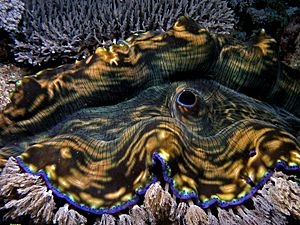Mantle (mollusc) facts for kids
The mantle is a special part of a mollusc's body. It's like a cloak or cape that covers important organs inside, such as those for digestion, reproduction, and movement. The word mantle actually means cloak or cape, and it often looks like one!
For many molluscs, the mantle also creates their shell. It does this by making a hard material called calcium carbonate. The edges of the mantle can stretch out far from the main body, forming flaps or double layers. These parts can be used for many different things, like making a siphon.
Contents
The Mantle Cavity
The mantle cavity is a very important space inside a mollusc. This space is formed by a double fold of the mantle, which creates a water-filled area. Inside this area, you can find the mollusc's gills, its anus, and organs for taste, getting rid of waste, and reproducing.
How the Mantle Cavity Helps Molluscs
The mantle cavity helps all molluscs breathe. It works like a breathing chamber. In molluscs like clams and oysters (called bivalves), this cavity is also used for feeding.
For some molluscs, the mantle cavity acts as a safe place to hold their young. In cephalopods (like squids and octopuses) and some bivalves (like scallops), the mantle cavity helps them move around.
Mantle and Movement
The mantle is very muscular. Cephalopods use their mantle muscles to push water out through a tube called a siphon. This action makes the animal shoot quickly through the water, which is called jet propulsion. In other molluscs, the mantle can be used like a "foot" to help them move.
Images for kids
-
The cuttlefish uses its mantle cavity for jet propulsion.
-
The marine gastropod Cypraea chinensis, the Chinese cowry, showing its partially extended mantle.
-
The mantle and the head of this slug Bielzia coerulans are smooth.
See also
 In Spanish: Manto (moluscos) para niños
In Spanish: Manto (moluscos) para niños










